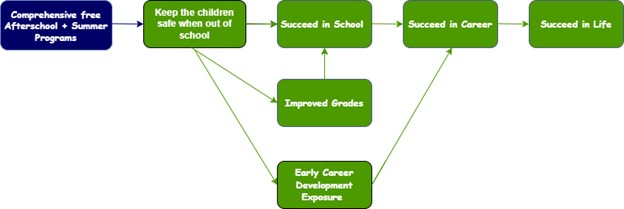Program theory and impact theory graph
Based on the mission and vision statements of After-School All-Stars program, comprehensive free afterschool and summer programs can have several outcomes. First, it can contribute to keep the children safe when they are out of school.
In fact, according to The Office of Juvenile Justice and Delinquency Prevention (2006), the incidence of violent crimes committed by youth peaks in the hours immediately following the end of the school day, with close to 1 in 5 juvenile violent crimes taking place in the hours between 3 and 7 p.m. In addition, in their report, the Office found that the risk of violent juvenile victimization was 60 percent greater in the four hours after school than in the 8 p.m.-to-midnight period on non-school days (Office of Juvenile Justice and Delinquency Prevention, 2006 as cited in Afterschool Alliance, 2014).
Secondly, when children are kept in a safe environment, they can improve their grades and succeed at school, implying they graduate from High School and go to College. For instance, a national evaluation found that more than 40 percent of students attending 21st Century Community Learning Center programs improved their reading and math grades, and that those who attended more regularly were more likely to make gains (Naftzger et al., 2007 as cited in Youth.org, n.d.).
Moreover, success at school and early career development exposure can lead to success in career. Some researchers pointed out that developing some soft skills are essential for work force development and lead to more youth being hired and successful in their jobs (Lippman, Ryberg, Carney, & Moore, 2015 as cited in Youth.org, n.d.).
Finally, according to the theory behind the program, success in career can lead to success in life.
